(Irresistible) Street Foods of South East Asia Through My Lens by Muslim Harji
Editor’s note: Intrepid globetrotter Muslim Harji of Montreal had a trip of a lifetime when he recently visited Vietnam, Cambodia and Myanmar (formerly known as Burma). Earlier we published a photo essay about his visit to the Ismaili jamatkhana in Rangoon, Burma (Photo Essay: The Ismaili Jamatkhana in Myanmar, With Notes on the Community’s Patriotic Spirit). This second photo essay, in a 3-part South East Asia series, covers his adventures and experiences with the delicious mouth-watering street foods of South East Asia. No traveler would wish to miss this as well as other photo essays by a Canadian Ismaili photographer, whose lens captures the extraordinary!
________
BY MUSLIM HARJI
(Special to Simerg)
South East Asia is famous for its street food, but the sad fact is that many visitors are either too scared to try it or have no idea what to order or where to start! Its true with the abundance of stalls selling a huge variety of dishes ranging from curries, soups, noodles and rice dishes to fruit, dried squid, meatballs, kebabs and deep-fried snacks – the experience can be overwhelming to say the least. What will I order? How will I know what I’m eating?
Unlike the food cooked behind curtains in dirty restaurant kitchens, your cook prepares the meal directly in front of you within plain view.
~~~~~~~~
MYANMAR

Fried bread stick (sort of doughnut), vegetables fried in batter, and deep-fried vegi dumplings in Rangoon or Yangoon.

Samosa, pakora and spring roll vendor, Shulle Paya, Rangoon.
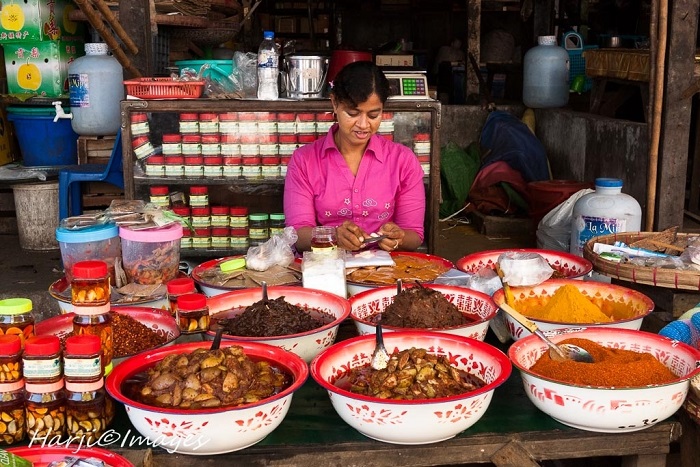
Marinated pickle (achar) vendor, Rangoon, Burma
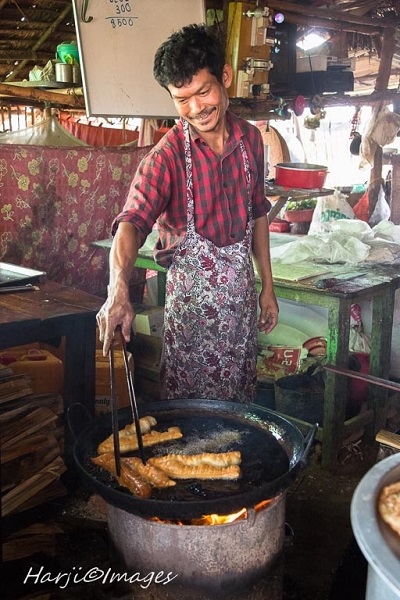
Deep fried flat bread (doughnut) in the making, Inle lake, Burma.
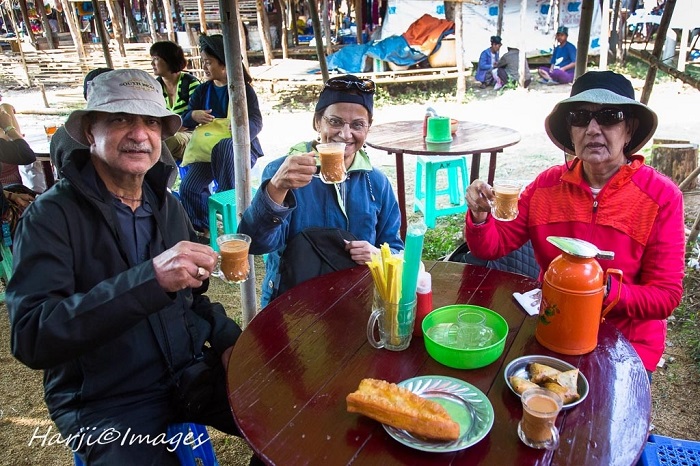
Milk tea is served around the sidewalks in Yangoon. Morning and evening is the most appropriate time to enjoy this tea. Similar to chai in India, Myanmar milk tea is black tea, mixed with sweetened condensed milk, accompanied with Indian flatbread that is sprinkled with sugar, or samosas.
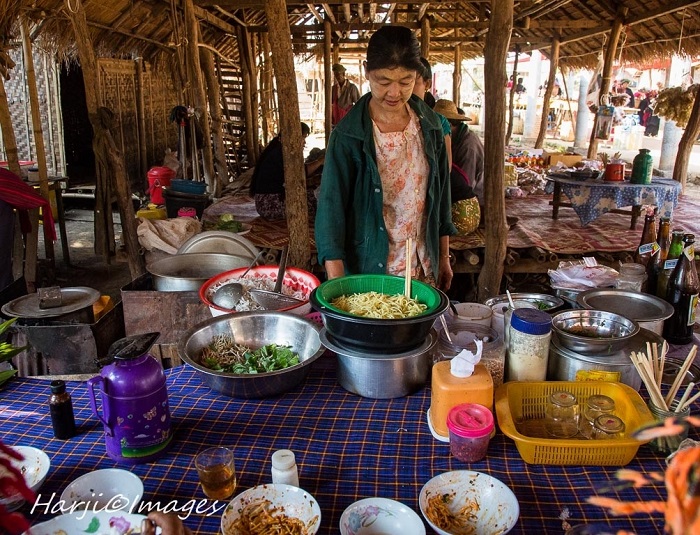
Noodle stall in Shan State. Myanmar. The dish most commonly associated with Shan State is this combination of thin, flat rice noodles in a clear, peppery broth with marinated meat, garnished with toasted sesame and a drizzle of garlic oil. It’s served with a side of pickled vegetables.
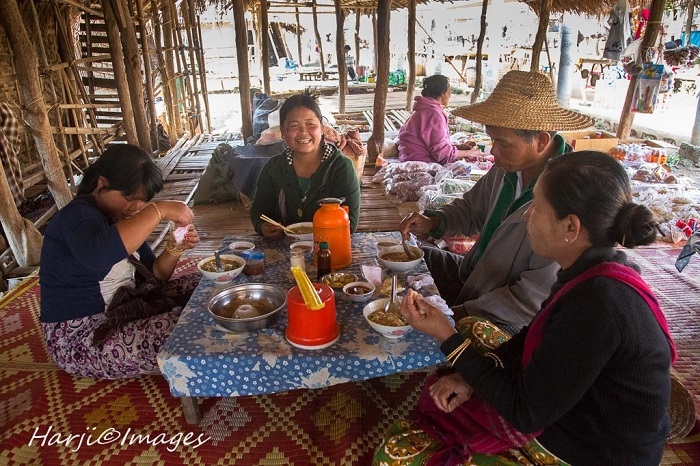
A shan family enjoying a road side noodle meal. Time and energy are rarely wasted on ambiance; instead, the cook focuses on serving great food for the lowest price possible. While you may or may not have a comfortable place to sit, hawker food is always cheaper than similar offerings in restaurants. Rather than commit to a single dish, you can often nibble, sample, and try several local specialties without breaking your budget.

Snacks Galore. Chevda, dall moth, fried channa and moong dall at open air market on Inle lake, Burma.
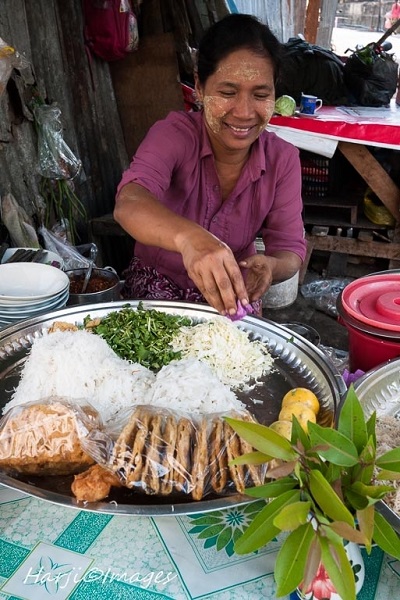
Noodles Burmese style.
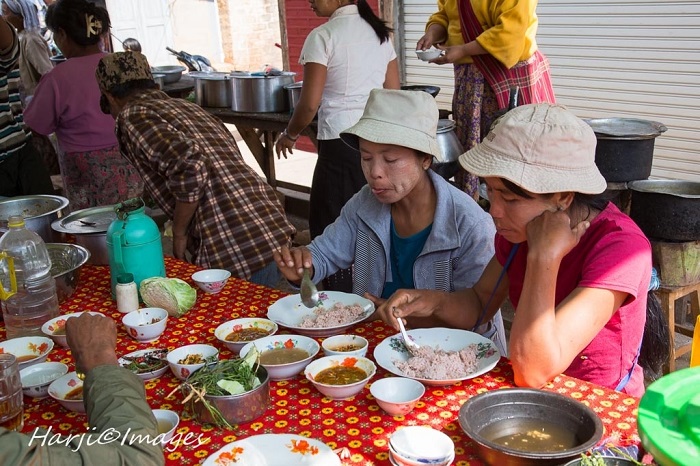
Locals enjoying variety of lip-smacking dishes.
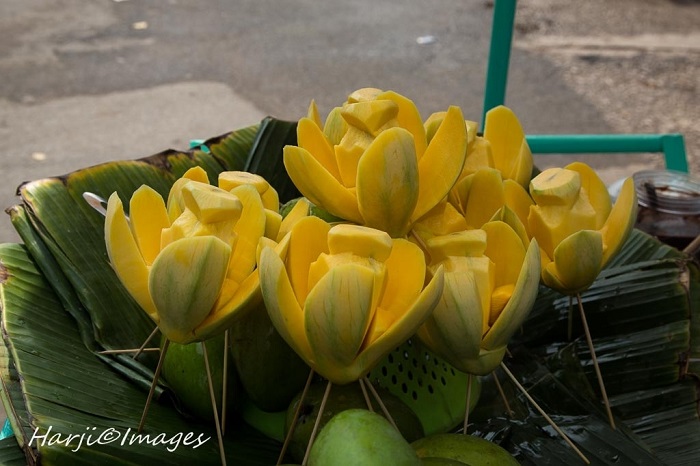
Mangoes, often picked before ripe and served with salt and freshly crushed hot peppers.
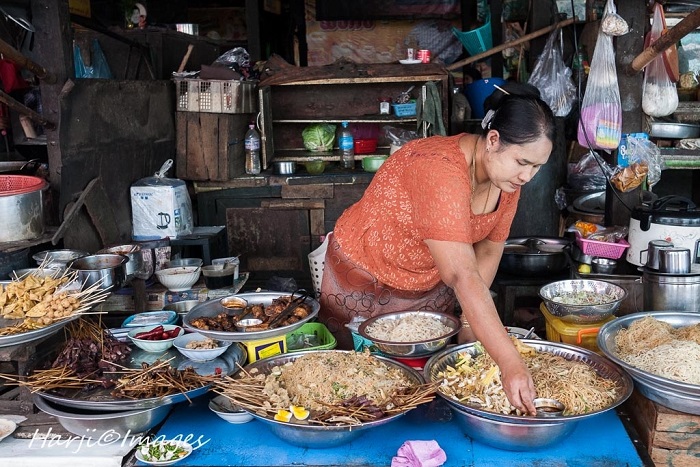

A young girl enjoying her task of frying a healthier version of roti/paratha! Sometimes called Indian Pancake this is a traditional flatbread that is available all over Myanmar. Typically eaten for breakfast, it can sometimes be found later in the day too. This plain and less oily incarnation of the deep-fried Bhaturas is often served with dry chickpea.
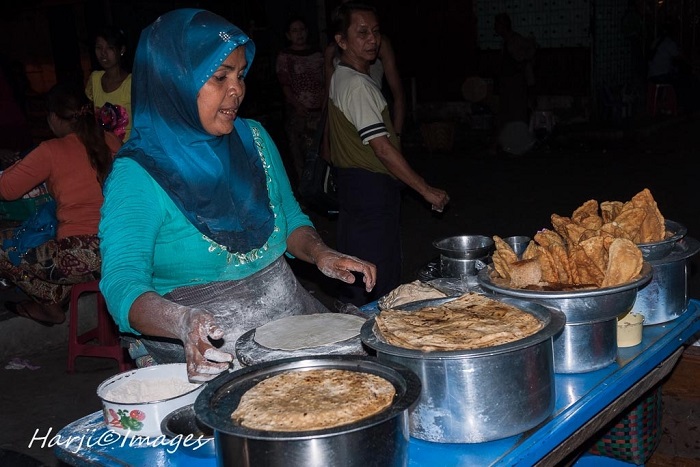
These street foods are simply irresistible! The best way to ensure a safe street food experience in Asia is to patronize carts that have a high turnover.
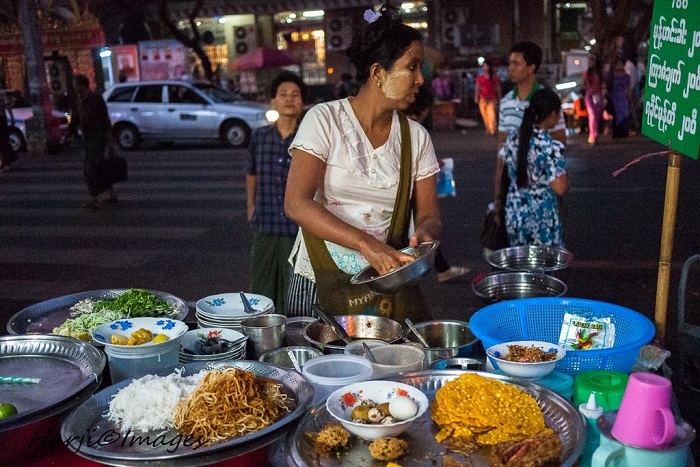
Street food variety.
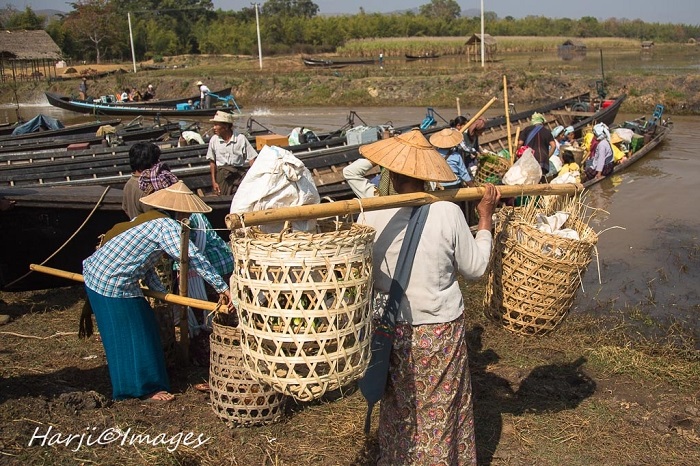
Street vendors bringing their wares to the city. Inle Lake, Burma

Paan Wallah. Betel chewing is a very old tradition in Myanmar. Small pavement stalls like this one are seen everywhere.
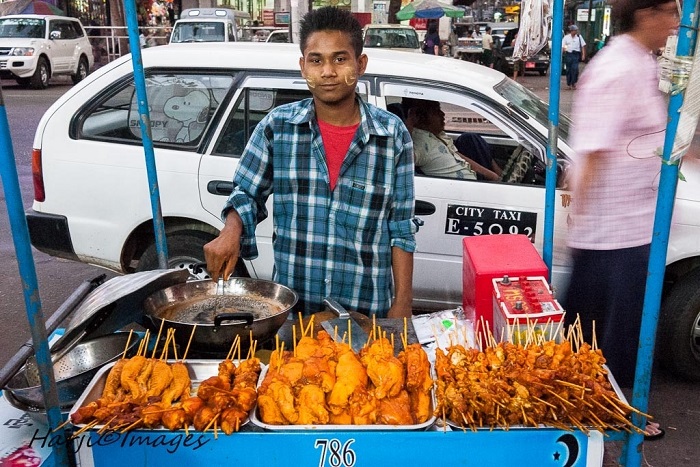
Halal Street Food. Although Myanmar is not a Muslim majority country, halal food is quite popular among the local Burmese people. Most of the shops that sell Muslim Halal food are small to medium size.
~~~~~~~~
VIETNAM AND CAMBODIA
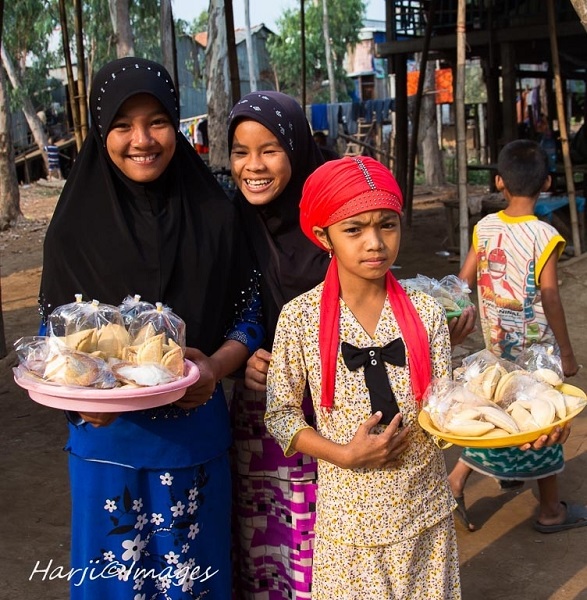
Sham Muslim Village in Mekong Delta, Vietnam Muslim girls selling traditional pastry stuffed with shredded coconut (singola) .

Sham Muslim Village, Mekong Delta . Vietnam. A cauldron of fresh vegetables & spices simmering to perfection and the soup served with rice or rice noodles.
~~~~~~~~
BANH MI – THE WORLD’S BEST KEPT SECRET? DISCOVER WHAT IT IS

Banh Mi, Vietnam. What is it? A little-known secret is that the world’s best sandwich isn’t found in Rome, Copenhagen or even New York City, but on the streets of Vietnam. It begins with a light baguette grilled over coals. After a smear of mayonnaise and a dollop of pâté, the crispy shell is filled with meat, crunchy pickled vegetables and fresh herbs. It is then seasoned with a few drops of soy sauce and a spicy chilli condiment. Tasting Banh mi is the epitome of street food: the sandwiches are sold almost exclusively from stalls and vendors.
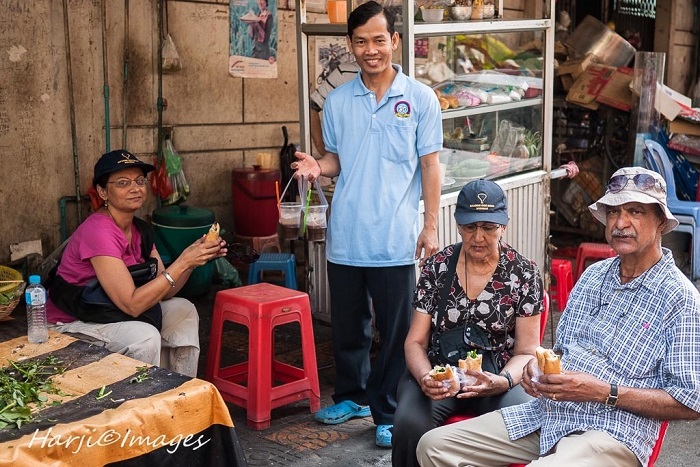
Enjoying Banh Mi with Vietnamese coffee on the streets of Saigon, Vietnam. Don’t expect a restaurant experience! Eating street food in Asia is about one thing: the food. With the exception of food courts where many hawker carts set up under one roof, you may find yourself perched on a simple plastic stool. Without the need to pay for real estate or hire staff, street food vendors have low overhead.
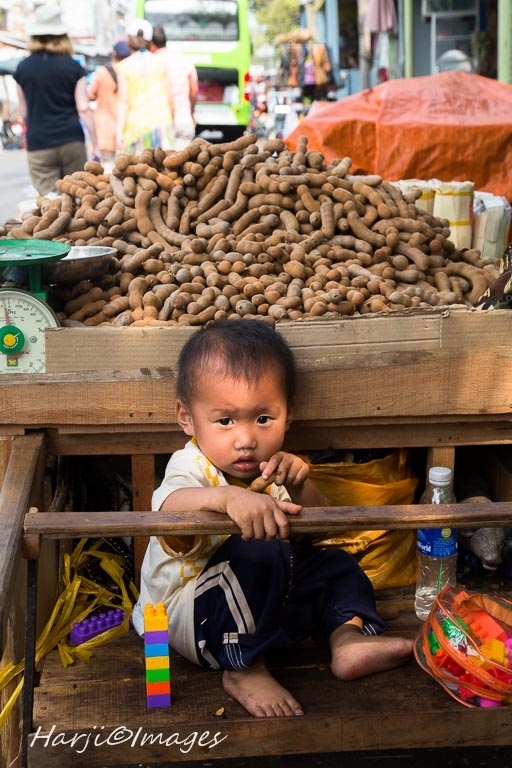
Fresh tamarind salesperson..:) in Can Tho, Vietnam
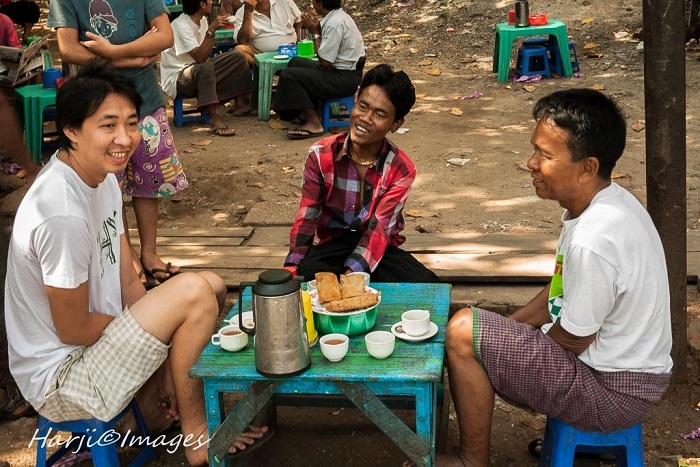
Breakfast with buddies, Cambodia
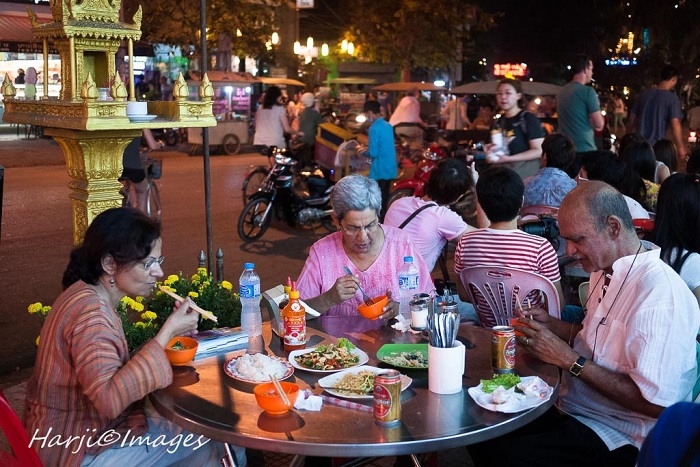
Talk about eating on the street! Siam Reap, Cambodia
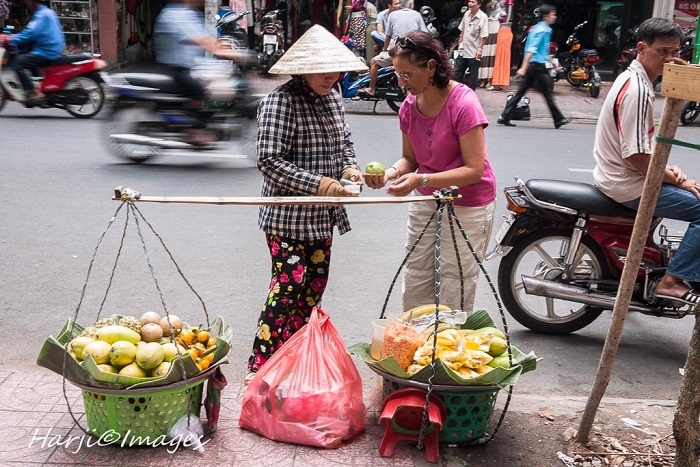
Fruit paradise…Vietnam.

A joyful vendor – fruits galore!
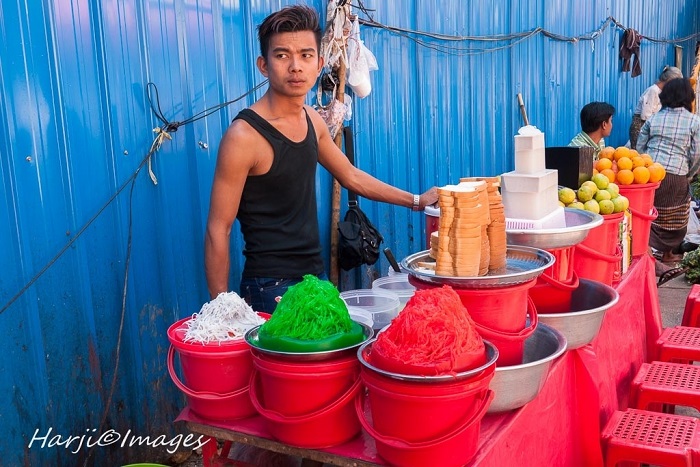
Noodle Sandwich..plain, lime or strawberry flavor…Vietnam
~~~~~~~
THE STINKIEST FOOD..NOTHING COMPARES WITH IT…BUT SAVOURED LIKED CHOCOLATE TRUFFLES
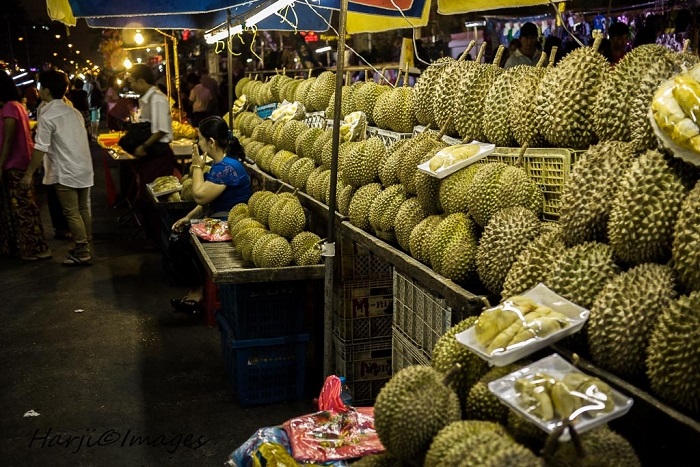
Durian – Learning to love durian: why the world’s stinkiest fruit is better than the best cheeses and chocolates. No other fruit creates such conflicting opinions. Throughout Southeast Asia the green, hedgehog-shaped “king of the fruits” is appreciated as haute cuisine to be savored like wine or truffles!
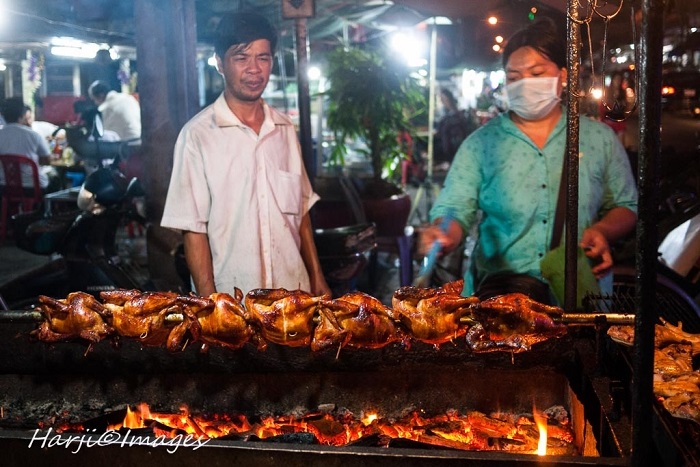
Heavenly street BBQ, Phnom Penh, Cambodia.

Mobile Pho kitchen, Hanoi, Vietnam PHO….I think it would be pretty impossible to travel to Vietnam and not eat pho, the most popular dish. Pho is noodle soup made with meat (my favourite is beef) herbs and bean sprouts. So many places in Vietnam claim to have the best pho around, so enjoy hopping from stall to stall, testing them all!
…..AND FINALLY…THE COLONIAL LEGACY
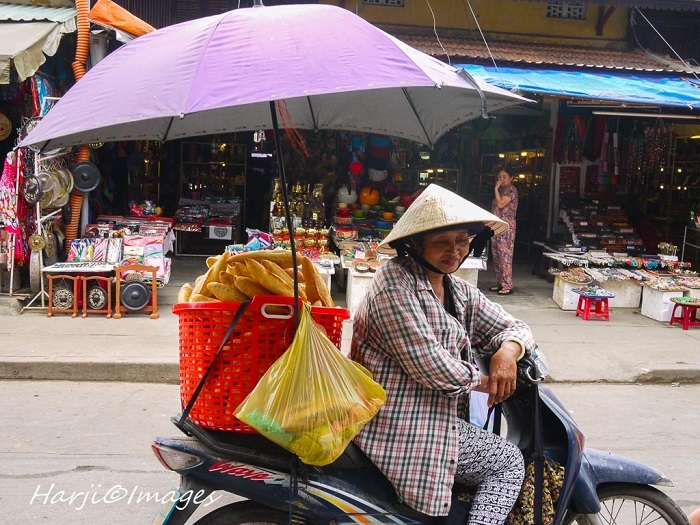
Baguette vendor, Hoi An, Vietnam. Baguette are a remnant from the French Colonial period and are still eaten widely throughout Vietnam. With a lighter crust than their European counterparts, the rolls are usually filled with cold meat and salad, including classic Vietnamese pickled carrots.
_______________
Muslim Harji’s tips for enjoying street food
- Look for busier carts — this is a good sign that ingredients are fresh and the food is good;
- Eat at carts frequented by locals; no one knows better where to find good food than the local residents;
- Get away from the tourist strip. Simply going a street or two away from the main tourist drag often yields better food by more caring hawkers;
- Bring small change as a courtesy. Hawker carts are the worst place to break that big bank-note you just got out of the ATM;
- If you buy a drink, leave the can or bottle at the cart. Many places in Asia offer a return on bottles and cans; many street vendors make a living out of this; and
- Cooks will often customize your order; they will happily leave out an ingredient that you do not like.
Yes street food is safe to eat. Most of the cases of stomach upsets are untreated water and ice-cubes as well as brushing teeth and having fruits and salads that are not washed in clean, filtered or boiled water. With cooked foods you’re fine. In fact I prefer seeing food prepared and cooked in front of me, as anything might be happening behind the kitchens’ closed doors!
Date posted: Sunday, June 8, 2014.
Date last updated: Monday, June 9, 2014; 07:00 (EDT).
COPYRIGHT: Photos are Copyright Muslim Harji. 2014. Reproduction without the written consent of the photographer, Muslim Harji, is strictly prohibited.
______________
Profile of Muslim Harji at Contributors.
Please visit http://www.simerg.com (the literary website)
We welcome feedback/letters from our readers on the essay. Please use the Comments box which appears below. Your feedback may be edited for length and brevity, and is subject to moderation. We are unable to acknowledge unpublished letters.
For a complete list as well as links to photo essays published on this blog please click on Table of Contents.
My next adventure – thank you so very much for all the wonderful pictures and comments. I am now looking forward to eating the foods I saw in the pictures.
Naz Kanji
Some of the foods featured here look similar to those found in the Philippines. Bread sticks look like shakoy (except that they are twisted), achar (which sound like atsara), and traditional pastry stuffed with coconut found in the Mekong Delta look like buchi (in Cebu) or called Bukhayo in Siquijor. Green mangoes are paired with hipon (salty krill with chili) and tamarind is cooked and added with sugar to make it into candy. We also have spring rolls, durian (particularly in Davao) and several other fruits like santol, avocado, atis, starapple and jackfruit.
Pingback: Muslim Harji: “Street Foods of South East Asia Through My Lens” | Ismailimail
This photo article succeeded in taking me on a Holiday almost, to these wonderfully colourful and exotic countries with its warm-hearted people. As I love travelling and have not been able to do so in recent times, it indeed helped to whet my appetite again and I mean ‘appetite’ for the variety of food that the writer enjoyed in company with friendly people. Thank you for posting it in my favourite website of http://www.simerg.com
Beautiful !
Beautifully photographed and truly informative. As usual, a job very well done!
Dear Harji, It is such a pleasure to travel through your lens. I have traveled extensively throughout Asia and you bring back memories so dear to me. I could not agree more with you about street food. Eating where local people eat is the best way of staying healthy. It is also a way to experience the culture. Your pictures focus on people and their lives and their smiles are just beautiful. Where to next? You are an inspiration to live to the fullest!
Muslim, a well documented photo story that captures real life – food and people who are some of the finest and most friendly. The tea/coffee with condensed milk is an experience to have. Thank you and Malik for documenting.